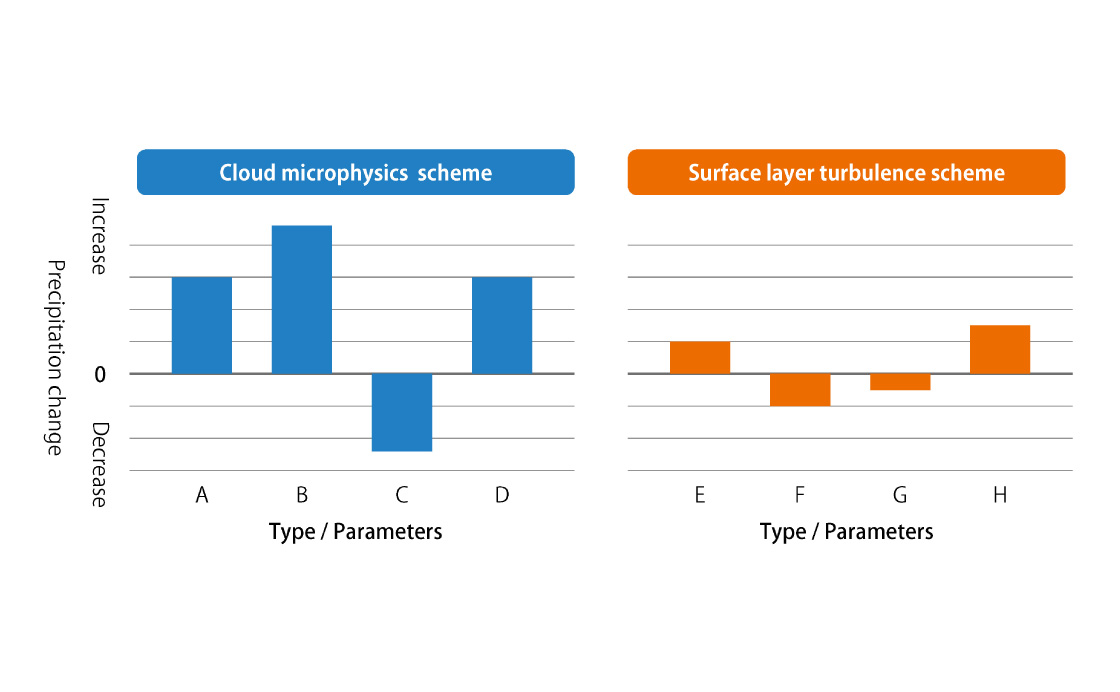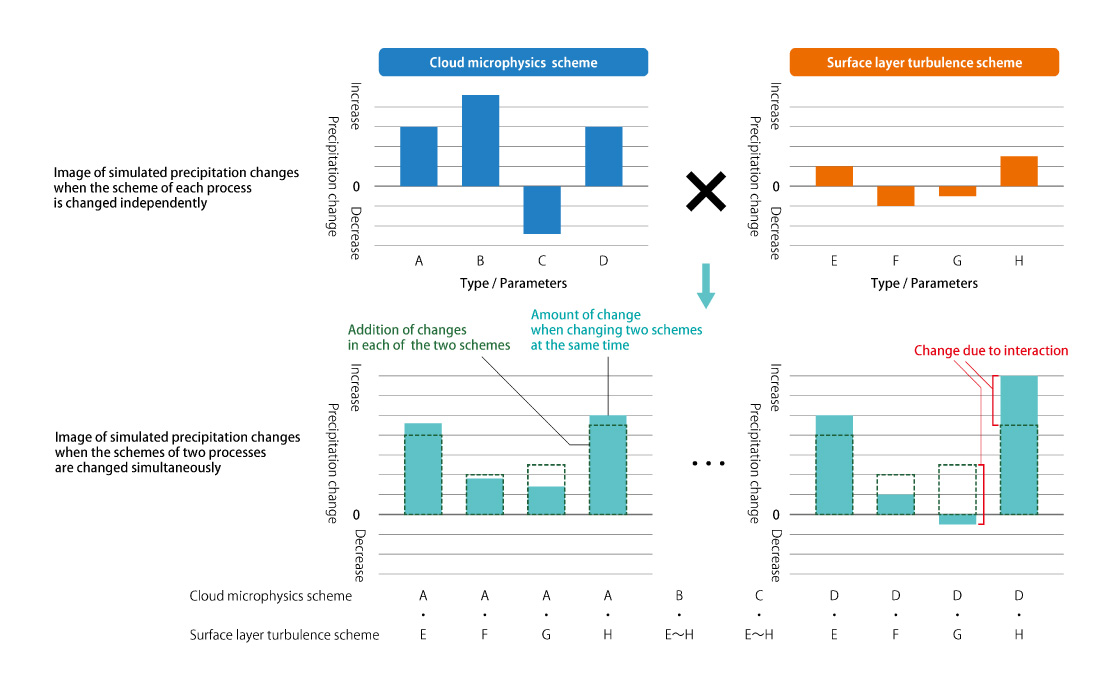Research overview
It is necessary to improve the accuracy of weather models to estimate the probability of precipitation phenomena to adopt weather control measures in the future, such as shifting the position of cumulonimbus clouds and linear rainbands to areas with no humans, to reduce wind- and flood-induced damage.
First, we investigate the magnitude of the impact of each element in the weather model on the simulation results, such as the location and time of cumulonimbus clouds and precipitation amount.
In the weather models simulating precipitation phenomena, various processes related to atmospheric motion are calculated separately. The calculation method for each process is called a “scheme.” The differences in the schemes significantly affect the simulation results.
In addition to these schemes, the resolution, which represents how finely or coarsely the atmosphere is spatially divided into grids, affects the simulation results.
In the uncertainty analysis, we will investigate the magnitude of the effect of each element, such as the scheme and resolution so that the relative importance of each element is revealed to determine which element should be prioritized and improved.
Details of research
The simulations of precipitation phenomena require the calculation of various processes related to atmospheric motion, such as heat transfer of the sun light, heat and water vapor exchanges between the sea, ground surfaces, and atmosphere, the fluxes of heat and water vapor in the atmosphere, and the generation and development of clouds. The calculation method for each process is called a “scheme.” The weather model consists of multiple schemes.
In the project, to improve the estimation accuracy of the probability of precipitation phenomena, such as cumulonimbus clouds and linear rainbands, some research groups began developing new schemes for the following four atmospheric processes: (1) "surface-layer turbulence,” used to more accurately calculate turbulence related to the heat and water vapor exchanges between the ground surface and the atmosphere; (2) "high-order numerical method for fluid calculation," which quantifies the atmospheric flow with high precision and high efficiency at a finer resolution of a model; (3) "Lagrangian particle-based cloud microphysics," which reproduces the formation and development of clouds and precipitation with high accuracy by explicitly taking into account water droplets and ice particles that construct clouds; and (4) “aerosol, cloud, precipitation, and lightning integration,” which addresses aerosols that create cloud droplets, development of clouds, and lightning occurrence in one scheme.
The schemes of the four processes are considered important for the accurate and robust prediction of severe weather phenomena and their probability estimation in weather models. In addition to the four processes, there are also various options for calculation settings, such as resolution and the calculation domain. It is necessary to pinpoint which elements are relatively more important for the high-accuracy reproduction of heavy precipitation phenomena.
It would be best, if it is possible to evaluate the effect of improvement of each scheme based on the "correct answer." However, there are no detailed observational data against which each process is validated, such as how heat and water vapor flow, and how clouds are generated and developed under complex weather conditions. Thus, the direct evaluation of simulation result using the “correct answer” is impossible. The same validation issue also applies to the improvement in the accuracy of probability estimation, where observation data from past cases of wind and flood damage are needed; however, there are not enough cases and observation data.
As a first step toward improving the accuracy of probability estimation in weather models, our task is to analyze which scheme generates a stronger impact on the predictions. Gauging the magnitude of this impact allows us to better understand which process should be focused on to improve the estimation accuracy.
How can the impact of each process scheme on the predictions be investigated? Each process scheme includes several calculation methods. Even within the same type, there are multiple ways to set parameters. For example, let us consider simulating precipitation amount for precipitation events that caused wind and flood damage in the past. Focusing on a process and changing the scheme type and parameters in various ways via one-at-a-time experiments enable us to measure how sensitive the simulated results are to these changes. The same procedure is applied to the other processes. Schemes with greater differences in the prediction results can be considered relatively more impactful.
In general, the cloud microphysics scheme, which calculates cloud formation and precipitation, is expected to exert a greater impact on the predictions than the other schemes. However, this has not been the case; the impact appears to differ depending on characteristics of precipitation events and their location.
In addition to the impact of each process scheme, we consider the impacts of the varying resolution of the weather models as well as the varying setting of the computational domain on the simulation results. Also, the difference in the initial conditions (e.g., air temperature and pressure) at the start of the calculation and the difference in the forecast period, from the start of the calculation to the occurrence of the desired weather phenomenon, affect the simulation results. Their impacts are analyzed in the same way as in each scheme described above. If the impacts of the resolution and initial values are relatively large, we should focus on improving their accuracy.
Another important point involves examining not only the effects of changing the scheme of each process one at a time, but also the effects of interactions between the schemes of multiple processes. Suppose that changing only the cloud microphysics scheme significantly changes the precipitation simulation results, whereas changing only the surface-layer turbulence scheme does not significantly change the prediction results. This in turn suggests that the surface-layer turbulence scheme does not significantly affect the prediction results.
However, if both schemes are changed simultaneously, the surface-layer turbulence scheme may exert a larger impact on the predictions than when it is changed alone, thus pointing to the importance of interaction effects. For example, given the interaction between the surface-layer turbulence scheme, which overestimates the amount of heat and water vapor fluxes from the ground surface, and the cloud microphysics scheme, which predicts that cumulonimbus clouds more easily develop due to their strong influence, it is possible that the precipitation amount of cumulonimbus clouds is simulated to be extremely large. Analysis of such interactions enhances our understanding of the impact of each scheme.
Such interactions may also occur between the schemes and the other model settings such as resolution as the estimated impact of each scheme on the simulation results may vary depending on the resolution.
We establish a method to analyze the effect of each element of the weather model on the predictions in detail and determine the elements that need to be improved. This in turn contributes to the development of new models with improved accuracy for estimating the probability of severe weather phenomena.





